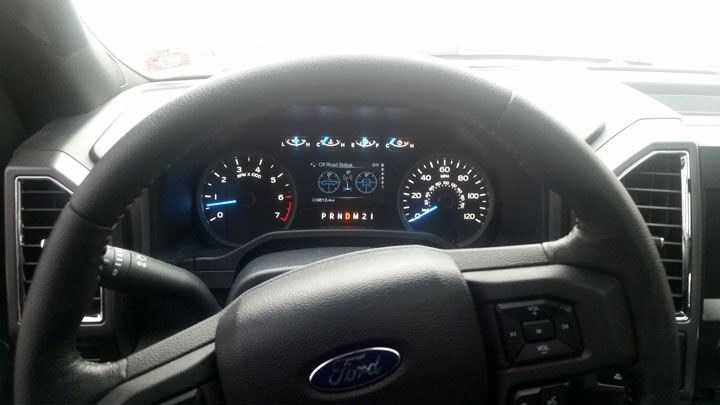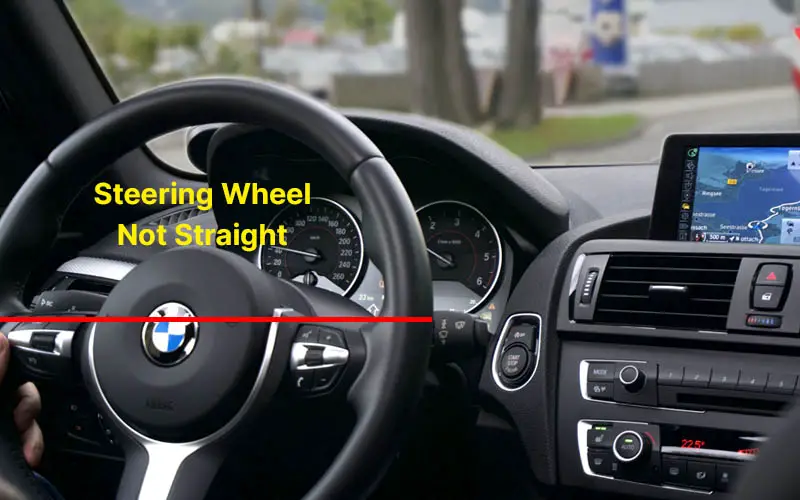Why isn’t my steering wheel straight? It’s a question that’s plagued drivers for ages, a symptom of various mechanical maladies that can leave you feeling like you’re driving a runaway rollercoaster. From the subtle wobble to the outright refusal to stay centred, a wonky steering wheel can be a real pain in the neck, literally.
But fear not, dear reader, for we’re about to delve into the labyrinthine world of steering wheel misalignment, dissecting the various culprits and offering a roadmap to navigate this perplexing predicament. We’ll explore the mechanical suspects, from tie rods to suspension parts, and unravel the mysteries of wheel alignment, tyre wear, and even those pesky driving habits that can throw your steering wheel off kilter.
So buckle up, grab a cuppa, and let’s get to the bottom of this wheel-y big problem.
Mechanical Issues

A misaligned steering wheel can be caused by various mechanical issues within your vehicle’s steering and suspension systems. These problems can range from minor wear and tear to more serious damage, impacting your vehicle’s handling and safety. Understanding the potential causes and how to diagnose them is crucial for maintaining your vehicle’s optimal performance and ensuring a safe driving experience.
Common Mechanical Issues
Mechanical issues are often the culprits behind a misaligned steering wheel. These issues can stem from wear and tear, damage, or improper adjustments. Here’s a table highlighting some common mechanical issues, their symptoms, and potential solutions:
| Issue | Symptoms | Solutions |
|---|---|---|
| Worn Tie Rod Ends | Uneven tire wear, loose steering, steering wheel not returning to center | Replace worn tie rod ends. |
| Damaged Ball Joints | Clicking or popping sounds when turning, loose steering, uneven tire wear | Replace damaged ball joints. |
| Loose Steering Wheel | Excessive play in the steering wheel, difficulty maintaining a straight path | Inspect and tighten steering wheel components. |
| Worn Suspension Components | Vehicle bouncing or swaying, uneven tire wear, loose steering | Replace worn suspension components, including struts, shocks, and control arms. |
| Bent Steering Column | Steering wheel not returning to center, difficulty steering | Inspect and repair or replace the steering column. |
Inspecting Steering Components
Inspecting steering components is a crucial step in diagnosing the cause of a misaligned steering wheel. This process involves a thorough examination of the tie rods, ball joints, and suspension parts.
Tie Rods
Tie rods are essential components connecting the steering rack to the wheels. Inspect the tie rod ends for any signs of wear, damage, or looseness.
Important: Worn or damaged tie rod ends can cause a loose steering feel and uneven tire wear.
Ball Joints
Ball joints connect the steering knuckles to the suspension control arms. Inspect the ball joints for any signs of play, excessive movement, or damage.
Important: Damaged ball joints can lead to a clicking or popping sound when turning, loose steering, and uneven tire wear.
Suspension Parts
Inspect suspension components like struts, shocks, control arms, and bushings for signs of wear, damage, or looseness.
Important: Worn or damaged suspension components can affect the vehicle’s handling and stability, contributing to a misaligned steering wheel.
Alignment Problems

Imagine driving down the road and feeling like your car is constantly pulling to one side, even when you’re holding the steering wheel straight. This is a common symptom of misalignment, a problem that can affect both your driving experience and the safety of your vehicle. Wheel alignment is crucial for maintaining a safe and comfortable ride. It ensures that your car’s wheels are positioned correctly in relation to each other and to the road.
Proper alignment minimizes tire wear, improves fuel efficiency, and ensures that your car handles smoothly.
Types of Alignment Adjustments
A wheel alignment involves adjusting several key angles to ensure proper wheel positioning. These angles are measured and adjusted using specialized equipment by a trained mechanic. Here are the main types of alignment adjustments:
- Toe: Toe refers to the angle of the wheels as viewed from the front of the car. If the wheels are pointing slightly inward, it’s called toe-in. If they point slightly outward, it’s called toe-out. Proper toe alignment ensures that the wheels track straight, minimizing tire wear and steering effort.
- Camber: Camber is the angle of the wheels as viewed from the side of the car. A positive camber angle means the top of the wheel is tilted outward, while a negative camber angle means the top of the wheel is tilted inward. Proper camber ensures even tire wear and improves handling stability.
- Caster: Caster is the angle of the steering axis as viewed from the side of the car. A positive caster angle means the steering axis is tilted backward, while a negative caster angle means it’s tilted forward. Proper caster improves steering stability and helps the wheels return to a straight position after turning.
Getting a Wheel Alignment
When you suspect alignment problems, it’s important to get your car checked by a qualified mechanic. The process typically involves the following steps:
- Inspection: The mechanic will visually inspect your tires and suspension components for any signs of damage or wear. They will also check for any leaks or loose parts that could be contributing to misalignment.
- Measurement: Using specialized equipment, the mechanic will measure the current alignment angles of your wheels. These measurements will be compared to the manufacturer’s specifications to determine if any adjustments are needed.
- Adjustment: If adjustments are required, the mechanic will use specialized tools to adjust the alignment angles. This typically involves adjusting the tie rods, camber bolts, or other suspension components.
- Re-measurement: After making adjustments, the mechanic will re-measure the alignment angles to ensure they are within the manufacturer’s specifications. They will also perform a test drive to ensure the car handles properly.
Tire Issues: Why Isn’t My Steering Wheel Straight
Uneven tire wear can significantly impact your steering wheel alignment, causing it to drift or pull to one side. This is because uneven tire wear creates imbalances in the tire’s contact patch with the road, affecting the vehicle’s handling and steering response.
Uneven Tire Wear Patterns
Understanding different tire wear patterns is crucial for identifying the underlying cause of your steering wheel misalignment. Here are some common wear patterns and their associated causes:
- Feathering: This pattern looks like a series of small, parallel ridges or grooves across the tire tread. It’s often caused by misaligned wheels or suspension components.
- Cupping: This pattern involves a series of rounded depressions or “cups” across the tire tread. It’s typically caused by worn or damaged shock absorbers or struts, leading to excessive bouncing.
- One-Sided Wear: This pattern involves excessive wear on one side of the tire tread.
It’s often caused by misaligned wheels, suspension problems, or improper tire inflation.
- Center Wear: This pattern involves excessive wear in the center of the tire tread. It’s typically caused by overinflation.
- Shoulder Wear: This pattern involves excessive wear on the tire’s shoulders. It’s often caused by underinflation.
Inspecting Tire Wear
Regularly inspecting your tires for wear patterns is essential for maintaining proper steering wheel alignment and ensuring safe driving. Here’s a step-by-step guide for inspecting tire wear:
- Park on a level surface. Ensure the vehicle is parked on a level surface to avoid any false readings.
- Check the tire tread depth. Use a tire tread depth gauge or a penny to check the remaining tread depth. The minimum legal tread depth in most countries is 2/32 inch.
- Inspect the tire sidewalls. Look for any cracks, bulges, or other signs of damage.
- Examine the tire tread pattern. Look for any signs of uneven wear, such as feathering, cupping, one-sided wear, center wear, or shoulder wear.
- Compare the wear patterns on all four tires. Check if the wear patterns are consistent across all tires.
Steering Wheel Components
The steering wheel itself can also contribute to a crooked steering wheel. Several components within the steering system can malfunction, causing alignment issues or affecting the steering wheel’s position. Understanding these components and their potential problems can help pinpoint the source of your steering wheel woes.
Steering Column
The steering column is the rigid shaft connecting the steering wheel to the steering gear. It’s a vital link in the steering system, allowing the driver’s input to be transmitted to the wheels. A bent steering column can result from a collision or a significant impact.
A bent steering column can cause the steering wheel to feel stiff or difficult to turn, or it might even cause the steering wheel to be misaligned.
A bent steering column is a serious safety hazard, as it can affect the driver’s control over the vehicle.
Steering Rack
The steering rack is responsible for converting the rotational movement of the steering wheel into linear motion, which in turn moves the wheels.
The steering rack is a complex component, consisting of gears, a rack, and tie rods.
A worn steering rack can lead to a variety of issues, including:
- Loose steering, where the steering wheel feels sloppy and doesn’t provide precise feedback.
- A clunking or knocking sound when turning the steering wheel.
- Difficulty steering, especially at low speeds.
- Steering wheel misalignment, where the steering wheel doesn’t return to center after turning.
Steering Wheel Components, Why isn’t my steering wheel straight
The steering wheel itself can also be a source of problems. A worn or damaged steering wheel can contribute to steering wheel misalignment.
A common issue is a worn steering wheel shaft, which can cause the steering wheel to wobble or shake at high speeds.
Another issue is a loose steering wheel, which can result from a worn steering wheel hub or a loose steering wheel nut.
A loose steering wheel can be a serious safety hazard, as it can detach from the steering column while driving.
Driving Habits

Your driving habits play a significant role in maintaining proper steering wheel alignment. Certain driving maneuvers and road conditions can gradually cause your steering wheel to become misaligned.
Impact of Driving Habits on Steering Alignment
Aggressive driving can have a noticeable impact on your steering wheel alignment.
- Hard braking: Applying the brakes abruptly can put stress on the suspension components, including the tie rods and control arms, which can lead to misalignment.
- Rapid acceleration: Similarly, accelerating quickly can also strain the suspension, causing the wheels to shift slightly out of alignment.
- Sharp turns: Making sharp turns at high speeds can place significant force on the steering system, potentially bending or damaging components and leading to misalignment.
Driving Tips to Prevent Steering Wheel Misalignment
Adopting a smoother and more controlled driving style can help prevent steering wheel misalignment.
- Avoid abrupt braking: Apply the brakes gradually and smoothly to minimize stress on the suspension components.
- Accelerate gradually: Avoid sudden bursts of acceleration, which can strain the suspension and lead to misalignment.
- Take turns smoothly: Avoid sharp turns, especially at high speeds. Instead, approach turns gradually and maintain a moderate speed.
- Be mindful of road conditions: Avoid driving on uneven surfaces or potholes as much as possible. These can cause sudden jolts and impact the steering alignment.
Impact of Uneven Surfaces on Steering Alignment
Driving on uneven surfaces, such as potholes, bumps, and rough roads, can significantly impact your steering alignment. These sudden impacts can cause the suspension components to shift or bend, leading to misalignment.
“Driving on uneven surfaces can cause the wheels to become misaligned, even if you’re driving carefully.”
So, there you have it, a comprehensive guide to the art of steering wheel straightness. From the intricacies of alignment to the tell-tale signs of worn components, we’ve covered the key suspects in this automotive mystery. Armed with this knowledge, you’ll be able to diagnose the issue, whether it’s a simple alignment tweak or a more serious mechanical malfunction.
Remember, a straight steering wheel isn’t just about aesthetics, it’s about safety and control. So, don’t let a wonky wheel get in the way of your driving pleasure – get it sorted and enjoy the smooth ride you deserve.
Key Questions Answered
How often should I get my car’s alignment checked?
It’s generally recommended to get your car’s alignment checked every 6-12 months, or sooner if you notice any signs of misalignment, such as a steering wheel that doesn’t stay straight or uneven tyre wear.
Can I adjust my steering wheel myself?
No, adjusting the steering wheel yourself can actually make the problem worse. It’s best to leave this task to a qualified mechanic.
What if my steering wheel is slightly off but doesn’t affect the driving?
Even a slight misalignment can lead to premature tyre wear and affect your car’s handling. It’s best to get it checked and fixed sooner rather than later.